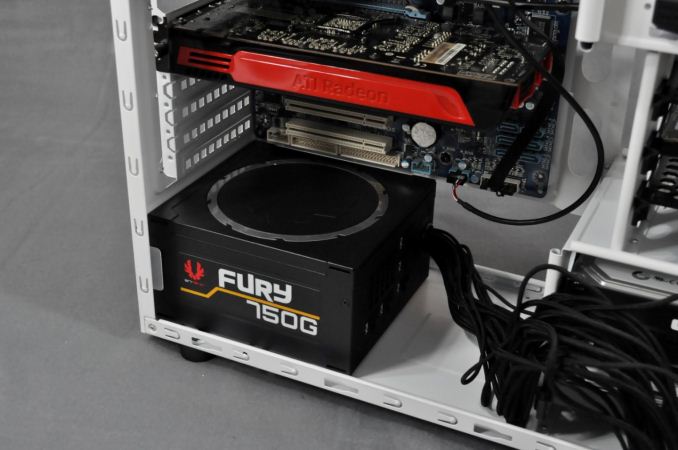BitFenix Neos Case Review
by E. Fylladitakis on January 21, 2015 9:00 AM EST- Posted in
- Cases/Cooling/PSUs
- bitfenix
- Case
Conclusion
BitFenix designed the Neos to be a low-cost yet stylish option for the average consumer that wants to build a simple system. It is a sound concept, as the vast majority of computer users will not be buying a case more expensive than $80-100. BitFenix offers the Neos for $50 to $75, depending on the color combination. A side panel window will cost the user an extra $18-20, bringing the minimum cost up to $70, pushing the boundaries of what most users would consider an acceptable price for a low-cost product. Still, the Neos would be an interesting choice as a stylish case for the casual user.
However, the Neos simply fails to deliver. Their aesthetic value is limited to the choice of a chassis/faceplate color combination. The neutral, minimalistic design is based on a low-cost SECC steel chassis, leaving the Neos without much to be proud of. With design being its major selling point, the Neos is certainly not faring very well. That however is just the tip of the iceberg formed by the cons of the Neos.
The chassis that the Neos is based on is, mildly put, archaic. We would not expect to see it used for anything other than the cheapest of cases nowadays. There is no clearance behind the motherboard tray and the cable/cooler cutouts appear to have been created with little thought for utility. No cages are removable and the use of destructible expansion card covers is nearly comedic (flashback to the 90s for those of us that are old enough). There is no top panel ventilation, it is not possible to use AIO liquid coolers, and the narrow chassis limits the selection of the CPU cooler as well, severely impeding the thermal management options.
The selection of the cooling fan is questionable as well. It would seem that BitFenix tried to balance the poor thermal performance of the Neos by installing a rather powerful 120mm fan... unsuccessfully. If it would help the Neos achieve good thermal performance, we could let this slide for a case of this price range, but the noisy 120mm fan is not enough to turn this outdated design into a competitive model.
Even for the price of the most basic model, the BitFenix Neos seems unable to face the competition. It would be able to house a typical PC without any issues, but there are many other and significantly more reasonable options within its price range. With its very poor thermal performance and virtually nonexistent versatility, it would be hard to recommend the Neos to any users, with the sole exception of those that simply really like its design.












54 Comments
View All Comments
GzeroD - Wednesday, January 21, 2015 - link
Any chance we could get some comparisons using some fans installed in the front 120mm fan slots?I wouldn't expect anyone to be putting 850W worth of components into a case like this without utilizing more of the fan mounting options.
E.Fyll - Thursday, January 22, 2015 - link
I wouldn't expect anyone to be putting 850W worth of components into this case. At all...We always test cases with their stock cooling options only. There is a virtually limitless number of possible cooling configurations for every single case out there, it is not possible to showcase them all. For instance, you requested the installation of two 120mm fans - which fans? 550 RPM silent fans or 5200 RPM Delta "jet engines"?
CosmonautDave - Thursday, January 22, 2015 - link
For what it's worth, the windowed version of the case comes with an additional front fan. So it would be "stock" if you had got that version. Maybe for the sake of comparison you could try this version with a 120mm front fan?vred - Wednesday, January 21, 2015 - link
"flashback to the 90s for those of us that are old enough"Great. Now I feel old. :D
Doomtomb - Wednesday, January 21, 2015 - link
Here's the deal with Bitfenix, they released the Prodigy in 2012 and took the mini-ITX PC crowd by storm. And then we have this.... they truly are a one-hit wonderStrangerGuy - Thursday, January 22, 2015 - link
You mean they made a mITX case that is almost as large or even larger than mATX cases. Case aesthetics are subjective that much I will admit, but I never understood their appeal from a pure functionality point of view because the entire point of the mITX is to f***ing save space.Antronman - Thursday, January 22, 2015 - link
Yeah I have to agree.And it's such a cramped case as well, despite being so large. If you fit a decent heatsink or a radiator, you can't have a DVD drive anymore. It's got 2 fan mount locations. I see so much wasted space.
StrangerGuy - Thursday, January 22, 2015 - link
Bitfenix Prodigy mITX = 24.9cm x 40.4cm x 35.9cm = 36.1LAerocool Dead Silence mATX cube = 26.5cm x 38.1cm x 41.1cm = 41.5L (only 14% larger)
Coolermaster N200 mATX tower = 37.8cm x 44.5cm x 20.1cm = 33.8L (Prodigy is LARGER by 7% despite being mITX only!)
I bet tons of a Prodigy just went "Oooooo mITX here" without doing the math for dimensions relative to form factor.
piasabird - Wednesday, January 21, 2015 - link
The metal mesh seems to have too small of holes. Probably makes the fans ineffective.ImSpartacus - Wednesday, January 21, 2015 - link
How long have the graphs used that gradient style?It looks like something an 8th grader would produce while they are still learning all of the features of Excel.
I don't know what visualization package you guys use, but you can do better. Sometimes less is more. This is Anandtech, not just some site.